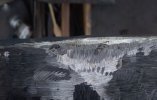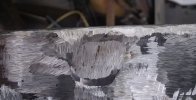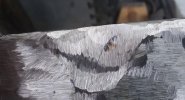weo
Basic Member
- Joined
- Sep 21, 2014
- Messages
- 3,086
Hello all. I thought I'd try a WIP for my next project, now that I'm getting back into the swing of things...literally.

My sister asked me to make a knife for a chef friend of hers who donated time and food for a dog rescue she volunteers at. In answer to the question of what size/style he wants, his response was: A small butcher's knife to break up turkeys. 5 1/2" blade length, 5 cm high at the heel, 5mm thick at the spine, square shaped WA handle 12 cm long. (Not sure why he mixed metric and english units, but I'm adaptable....)
Here are the sketches I sent him:

He picked the top shape, which kinda surprised me because he initially said he was thinking he wanted a santoku, but then changed his mind, saying he'd rather have a butcher's knife....
I decided to do a ladder pattern using a billet I had laying around. I'm not 100% sure, but I think this is 3 pieces of 25 layer 0.125" 1084/ 0.140" 15N20 separated by 0.140" thick layers of 15N20.
Here's the billet while grinding the grooves:

Looks like I need to go a bit deeper here:

Ladder grooves complete:

Stay tuned...forging planned for later today (if the wind stays down, but there is a winter storm forecast starting this afternoon).
PS - let me know if I y'all would rather I shrink the pics.
Suggestions, and constructive criticism is always welcome.
My sister asked me to make a knife for a chef friend of hers who donated time and food for a dog rescue she volunteers at. In answer to the question of what size/style he wants, his response was: A small butcher's knife to break up turkeys. 5 1/2" blade length, 5 cm high at the heel, 5mm thick at the spine, square shaped WA handle 12 cm long. (Not sure why he mixed metric and english units, but I'm adaptable....)
Here are the sketches I sent him:

He picked the top shape, which kinda surprised me because he initially said he was thinking he wanted a santoku, but then changed his mind, saying he'd rather have a butcher's knife....
I decided to do a ladder pattern using a billet I had laying around. I'm not 100% sure, but I think this is 3 pieces of 25 layer 0.125" 1084/ 0.140" 15N20 separated by 0.140" thick layers of 15N20.
Here's the billet while grinding the grooves:

Looks like I need to go a bit deeper here:

Ladder grooves complete:

Stay tuned...forging planned for later today (if the wind stays down, but there is a winter storm forecast starting this afternoon).
PS - let me know if I y'all would rather I shrink the pics.
Suggestions, and constructive criticism is always welcome.




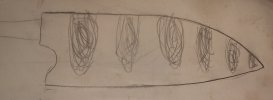

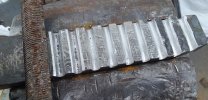


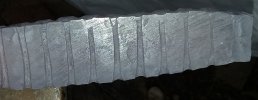



 Fortunately it's at the tip and I've got enough left to cut it off and move on...
Fortunately it's at the tip and I've got enough left to cut it off and move on...
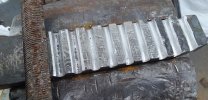

 4D467A92-107F-47DE-B308-C2B845DDA0C1
4D467A92-107F-47DE-B308-C2B845DDA0C1


